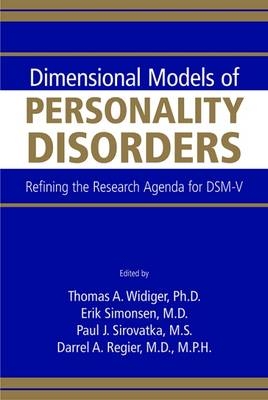
Dimensional Models of Personality Disorders
American Psychiatric Association Publishing (Verlag)
978-0-89042-296-0 (ISBN)
DSM-IV and ICD-10 both diagnose personality disorders categorically, yet studies indicate that many patients meet criteria for an excessive number of diagnoses, raising the question of whether personality disorders are discrete conditions or rather distinctions along dimensions of general personality functioning. This collection of papers renews long-standing proposals for a dimensional model of personality disorder, describing alternative models, addressing questions about their clinical application and utility, and suggesting that future research seek to integrate such models within a common hierarchical structure.
With contributions by preeminent researchers in the field, Dimensional Models of Personality Disorders is drawn from a conference series convened by APA, WHO, and NIH in order to plan for the fifth edition of the DSM. The Nomenclature Work Group concluded that consideration should be given to basing part or all of DSM-V on dimensions rather than categories, and recommended that a dimensional model for personality disorders should serve as a basis for exploring dimensional approaches in other areas. Accordingly, the volume opens with a presentation of 18 proposals for dimensional models and proceeds with provocative contributions on a number of related issues ranging from hard science to clinical practice. Among the topics addressed are
• Behavioral and molecular genetic research supporting an etiologically informed dimensional classification of personality disorders
• The as-yet tenuous associations between dimensional trait measures of personality as contained in the models of Cloninger, Depue, and Siever-Davis, and specific neurobiological measures, as examined in neurotransmitter research
• Potential links between childhood and adolescent temperament and personality dimensions and adult personality psychopathology
• Studies examining the covariation of personality dimensions across cultures
• The continuity of Axis I and Axis II disorders and a proposed hierarchical structure of mental disorders that integrates the psychopathology of Axis I disorders with specific personality traits
• The dual challenges of coverage and cutoffs that must be addressed if dimensional models are to be considered viable alternatives to the existing categorical diagnostic system
Although the editors acknowledge that concerns are certain to be raised regarding conversion to a dimensional classification—such as the disruption to clinical practice by a radical shift in diagnosing personality disorder—these papers make a strong case for opening the field to alternative ways of enhancing clinical utility and improving the validity of basic classification concepts. Together, they offer stimulating insight into how we approach personality disorders, with the hope of encouraging a new model of diagnosis for DSM-V.
Thomas A. Widiger, Ph.D., is professor in the Department of Psychology at the University of Kentucky in Lexington, Kentucky. Erik Simonsen, M.D., is Chief Psychiatrist at Roskilde County Hospital Fjorden and Medical Director at the Institute of Personality Theory and Psychopathology in Roskilde, Denmark. Paul J. Sirovatka, M.S., is Associate Director for Research at the American Psychiatric Institute for Research and Education and the Division of Research at the American Psychiatric Association in Washington, D.C. Darrel A. Regier, M.D., M.P.H., is Executive Director of the American Psychiatric Institute for Research and Education and Director of the Division of Research at the American Psychiatric Association in Washington, D.C.
Contributors
Disclosure statement
Foreword
Preface
Introduction
Chapter 1. Alternative dimensional models of personality disorder: finding a common ground
Chapter 2. Commentary on Widiger and Simonsen: toward a consensus personality trait structure
Chapter 3. Commentary on Widiger and Simonsen: working out a dimensional framework
Chapter 4. Commentary on Widiger and Simonsen: from ICD-10 and DSM-IV to ICD-11 and DSM-V
Chapter 5. Behavioral and molecular genetic contributions to a dimensional classification of personality disorder
Chapter 6. Commentary on Livesley: genetic contributions to a dimensional classification: problems and pitfalls
Chapter 7. Neurobiological dimensional models of personality: a review of three models
Chapter 8. Commentary on Paris: personality as a dynamic psychobiological system
Chapter 9. Commentary on Paris: the problem of severity in personality disorder classification
Chapter 10. Temperament and personality as broad-spectrum antecedents of psychopathology in childhood and adolescence
Chapter 11. Commentary on Mervielde et al.: toward a developmental perspective on personality disorders
Chapter 12. Personality dimensions across cultures
Chapter 13. Commentary on Allik: the lexical approach to the study of personality structure
Chapter 14. Commentary on Allik: a historical perspective on personality disorder
Chapter 15. Commentary on Allik: cross-cultural diagnosis of personality disorder
Chapter 16. Continuity of Axes I and II: toward a unified model of personality, personality disorders, and clinical disorders
Chapter 17. Commentary on Krueger: what to do with the old distinctions
Chapter 18. Commentary on Krueger: traits versus types in the classification of personality pathology
Chapter 19. Dimensional models: coverage and cutoffs
Chapter 20. Commentary on Trull: drizzling on the 5 3 factor parade
Chapter 21. Commentary on Trull: just do it: replace Axis II with a diagnostic system based on the Five-Factor Model of Personality
Chapter 22. Commentary on Trull: reservations and hopes
Chapter 23. Clinical utility of dimensional models for personality pathology
Chapter 24. Commentary on Verheul: focusing on the clinician's need for a better model
Chapter 25. Commentary on Verheul: clinical utility of dimensional models for personality pathology
Chapter 26. Personality disorder research agenda for DSM-V
Index
| Erscheint lt. Verlag | 11.12.2006 |
|---|---|
| Zusatzinfo | 10 Tables, unspecified; 1 Line drawings, black and white |
| Verlagsort | VA |
| Sprache | englisch |
| Maße | 152 x 229 mm |
| Gewicht | 408 g |
| Themenwelt | Medizin / Pharmazie ► Medizinische Fachgebiete ► Psychiatrie / Psychotherapie |
| ISBN-10 | 0-89042-296-6 / 0890422966 |
| ISBN-13 | 978-0-89042-296-0 / 9780890422960 |
| Zustand | Neuware |
| Haben Sie eine Frage zum Produkt? |
aus dem Bereich


